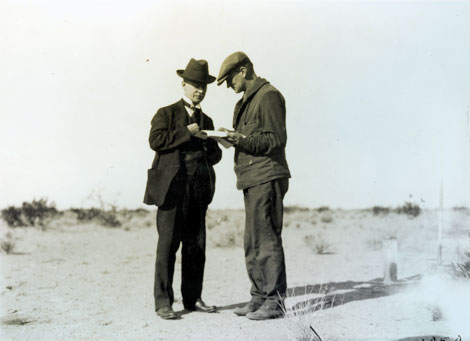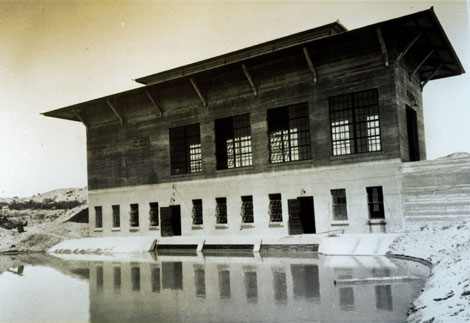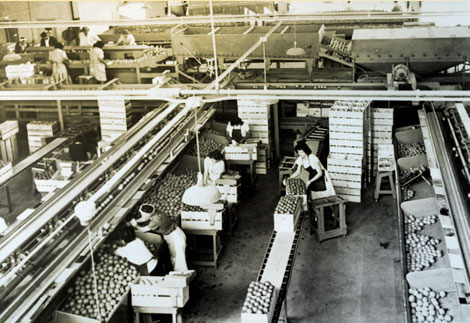

 A farmer and the Project Manager close a deal on a farm plot on Yuma Mesa, no date. (Reclamation photograph)
A farmer and the Project Manager close a deal on a farm plot on Yuma Mesa, no date. (Reclamation photograph) This 1922 photograph shows the forebay of the new power plant for the pump station constructed at the base of Yuma Mesa. (Reclamation photograph)
This 1922 photograph shows the forebay of the new power plant for the pump station constructed at the base of Yuma Mesa. (Reclamation photograph)South of the town of Yuma is Yuma Mesa. Ranging between 50 and 80 feet above the irrigated lands of the Yuma Valley Division to the west, the soil on Yuma Mesa is particularly good for growing citrus, particularly if there is a source of water. Even better, the higher lands are virtually frost free and perfect for citrus farming. Between 1918 and 1921, agricultural experts from the University of Arizona and Reclamation Service engineers and land surveyors combined forces to identify 532 farm units. Interested farmers eagerly bought up the farm units, of which all but 14 were sold by 1921.
With the sale of these farm units, the Reclamation Service launched an aggressive construction project to complete water delivery systems to the mesa fields. The irrigation plan called for diversion of Colorado River water into a canal heading on the California side of Laguna Dam. Canal water was carried by an inverted siphon under the Colorado River at Yuma. Once on the Arizona side, the water, once again on the surface, was carried by a main canal to a pumping plant located at the base of Yuma Mesa. At the pumping station, irrigation water was lifted some 72 feet to a main canal on the mesa for delivery to waiting farmers.
 Citrus packing shed of the Yuma Mesa Fruit Growers where workers grade and package fruit after it has traveled via a conveyor belt through cleaning and washing machines. (Reclamation photograph)
Citrus packing shed of the Yuma Mesa Fruit Growers where workers grade and package fruit after it has traveled via a conveyor belt through cleaning and washing machines. (Reclamation photograph)Despite favorable climate and early enthusiasm for agricultural development of the mesa lands, settlement and development proceeded very slowly. By 1923, only 300 acres of some 6,300 acres were planted, mostly in grapefruit. By the end of the decade, only 1,200 acres had been planted. The crux of the problem was two-fold: land speculators and inexperienced farmers, two problems that plagued many federal reclamation projects. The former could not sell their land because agricultural prices had declined; the latter had little idea of the costs of farming and lacked practical experience. Some savvy farmers managed to succeed, however, by forming syndicates. A typical syndicate was comprised of several farmers or investors who pooled their land and resources together in order to share the costs of farming and shipping produce. The Yuma Project manager agreed that this was the best use of mesa farm land.
Unfortunately, the Yuma Auxiliary Project never realized its potential of bringing 45,000 acres of mesa land under irrigation.
